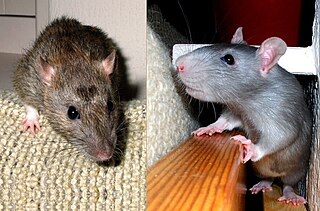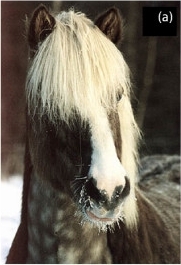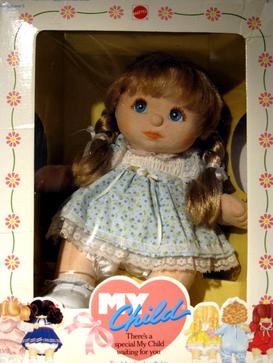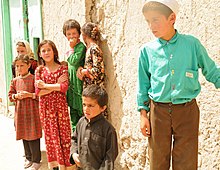
Brown is a color. It can be considered a composite color, but it is mainly a darker shade of orange. In the CMYK color model used in printing and painting, brown is usually made by combining the colors orange and black. In the RGB color model used to project colors onto television screens and computer monitors, brown combines red and green.

Melanin consist of oligomers or polymers arranged in a manner which among other functions provide the pigments of many organisms. Melanin pigments are produced in a specialized group of cells known as melanocytes. They have been described as "among the last remaining biological frontiers with the unknown".

Human hair color is the pigmentation of human hair follicles due to two types of melanin: eumelanin and pheomelanin. Generally, if more melanin is present, the color of the hair is darker; if less melanin is present, the hair is lighter. The tone of the hair is dependent on the ratio of black or brown eumelanin to yellow or red pheomelanin. Levels of melanin can vary over time causing a person's hair color to change, and it is possible to have hair follicles of more than one color on the same person. Some hair colors are associated with some ethnic groups due to observed higher frequency of particular hair color within their geographical region, e.g. straight dark hair amongst East Asians, Southeast Asians, Polynesians, Central Asians and Native Americans, a large variety of dark, fair, curly, straight, wavy and bushy hair amongst Europeans, West Asians, Central Asians and North Africans, curly, dark, and uniquely helical hair with Sub Saharan Africans, whilst gray, white or "silver" hair is often associated with age.

Blond or blonde, also referred to as fair hair, is a human hair color characterized by low levels of eumelanin, the dark pigment. The resultant visible hue depends on various factors, but always has some yellowish color. The color can be from the very pale blond to reddish "strawberry" blond or golden-brownish ("sandy") blond colors. Occasionally, the state of being blond, and specifically the occurrence of blond traits in a predominantly dark or colored population are referred to as blondism.

A dilution gene is any one of a number of genes that act to create a lighter coat color in living creatures. There are many examples of such genes:

Bay is a hair coat color of horses, characterized by a reddish-brown or brown body color with a black point coloration on the mane, tail, ear edges, and lower legs. Bay is one of the most common coat colors in many horse breeds.
At right is displayed the color traditionally called liver.

The cream gene is responsible for a number of horse coat colors. Horses that have the cream gene in addition to a base coat color that is chestnut will become palomino if they are heterozygous, having one copy of the cream gene, or cremello, if they are homozygous. Similarly, horses with a bay base coat and the cream gene will be buckskin or perlino. A black base coat with the cream gene becomes the not-always-recognized smoky black or a smoky cream. Cream horses, even those with blue eyes, are not white horses. Dilution coloring is also not related to any of the white spotting patterns.

The silver or silver dapple (Z) gene is a dilution gene that affects the black base coat color and is associated with Multiple Congenital Ocular Abnormalities. It will typically dilute a black mane and tail to a silvery gray or flaxen color, and a black body to a chocolaty brown, sometimes with dapples. It is responsible for a group of coat colors in horses called "silver dapple" in the west, or "taffy" in Australia. The most common colors in this category are black silver and bay silver, referring to the respective underlying coat color.

Equine coat color genetics determine a horse's coat color. Many colors are possible, but all variations are produced by changes in only a few genes. Bay is the most common color of horse, followed by black and chestnut. A change at the agouti locus is capable of turning bay to black, while a mutation at the extension locus can turn bay or black to chestnut.

Auburn hair is a human hair color, a variety of red hair, most commonly described as reddish-brown in color. Auburn hair ranges in shades from medium to dark. It can be found with a wide array of skin tones and eye colors. The chemical pigments that cause the coloration of auburn hair are frequently pheomelanin with high levels of eumelanin; however, the auburn hair is due to a mutated melanocortin 1 receptor gene in Northwestern European people and by a mutated TYRP1 gene in the Melanesians and Austronesians, both genes that reduce the melanin production of the hair cells.

Chestnut is a hair coat color of horses consisting of a reddish-to-brown coat with a mane and tail the same or lighter in color than the coat. Chestnut is characterized by the absolute absence of true black hairs. It is one of the most common horse coat colors, seen in almost every breed of horse.

Horses exhibit a diverse array of coat colors and distinctive markings. A specialized vocabulary has evolved to describe them.
Black hair is the darkest and most common of all human hair colors globally, due to large populations with this trait. This hair type contains a much more dense quantity of eumelanin pigmentation in comparison to other hair colors, such as brown, blonde and red. In English, various types of black hair are sometimes described as soft-black, raven black, or jet-black. The range of skin colors associated with black hair is vast, ranging from the palest of light skin tones to dark skin. Black-haired humans can have dark or light eyes.

Black is a hair coat color of horses in which the entire hair coat is black. Black is a relatively uncommon coat color, and it is not uncommon to mistake dark chestnuts or bays for black.

My Child dolls are a toy made by Mattel from 1985-1988. Most had felt "skin" on their heads although some had vinyl skin.

A sooty or smutty horse coat color is characterized by black or darker hairs mixed into a horse's coat, typically concentrated along the topline of the horse and less prevalent on the underparts. The effect is especially pronounced on buckskins and palominos. Sootiness is believed to be an inherited trait involving multiple genes, however the details are not yet known. Horses without any visible sooty coloration are termed "clear-coated."

Amelanism is a pigmentation abnormality characterized by the lack of pigments called melanins, commonly associated with a genetic loss of tyrosinase function. Amelanism can affect fish, amphibians, reptiles, birds, and mammals including humans. The appearance of an amelanistic animal depends on the remaining non-melanin pigments. The opposite of amelanism is melanism, a higher percentage of melanin.

Dark skin is a type of human skin color that is rich in melanin pigments. People with dark skin are often referred to as "black people", although this usage can be ambiguous in some countries where it is also used to specifically refer to different ethnic groups or populations.
The blonde versus brunette rivalry is a rivalry—whether real, imagined, or fictional—between women with blonde hair and those with brown (brunette) hair. In popular culture and everyday conversation, the words blonde and brunette are sometimes used as nouns to refer to women by these two hair colors. This supposed rivalry is a common fictional theme in books, magazine articles, film, and television. Some have argued that the spectacle of blonde and brunette women engaged in physical fights with each other has been a male fantasy for many years.


























